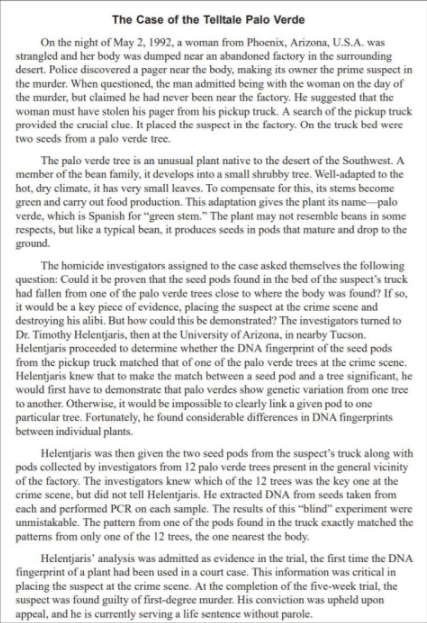How did the investigators conclude that the suspect was indeed the murderer? 2. What if a strand of hair was found in the truck bed instead of a seed pod, do you think it will still lead to the identification of the suspect? 3. What do you think are the other uses of DNA fingerprinting?
How did the investigators conclude that the suspect was indeed the murderer? 2. What if a strand of hair was found in the truck bed instead of a seed pod, do you think it will still lead to the identification of the suspect? 3. What do you think are the other uses of DNA fingerprinting?
Essentials of Pharmacology for Health Professions
7th Edition
ISBN:9781305441620
Author:WOODROW
Publisher:WOODROW
Chapter1: Consumer Safety And Drug Regulations
Section: Chapter Questions
Problem 12CRQ
Related questions
Question
Questions:
1. How did the investigators conclude that the suspect was indeed the murderer?
2. What if a strand of hair was found in the truck bed instead of a seed pod, do you think it will still lead to the identification of the suspect?
3. What do you think are the other uses of DNA fingerprinting?
4. Why do you think the discovery of the seed pods provided the most crucial clue?
5. What were the clues that led to the identification of the suspect?
6. What if the strand of hair belonged to the victim, what other clues would you look for?

Transcribed Image Text:The Case of the Telltale Palo Verde
On the night of May 2, 1992, a woman from Phoenix, Arizona, U.S.A. was
strangled and her body was dumped near an abandoned factory in the surrounding
desert. Police discovered a pager near the body, making its owner the prime suspect in
the murder. When questioned, the man admitted being with the woman on the day of
the murder, but claimed he had never been near the factory. He suggested that the
woman must have stolen his pager from his pickup truck. A search of the pickup truck
provided the crucial clue. It placed the suspect in the factory. On the truck bed were
two seeds from a palo verde tree.
The palo verde tree is an unusual plant native to the desert of the Southwest. A
member of the bean family, it develops into a small shrubby tree. Well-adapted to the
hot, dry climate, it has very small leaves. To compensate for this, its stems become
green and carry out food production. This adaptation gives the plant its name-palo
verde, which is Spanish for "green stem." The plant may not resemble beans in some
respects, but like a typical bean, it produces seeds in pods that mature and drop to the
ground.
The homicide investigators assigned to the case asked themselves the following
question: Could it be proven that the seed pods found in the bed of the suspect's truck
had fallen from one of the palo verde trees close to where the body was found? If so,
it would be a key piece of evidence, placing the suspect at the crime scene and
destroying his alibi. But how could this be demonstrated? The investigators turned to
Dr. Timothy Helentjaris, then at the University of Arizona, in nearby Tucson.
Helentjaris proceeded to determine whether the DNA fingerprint of the seed pods
from the pickup truck matched that of one of the palo verde trees at the crime scene.
Helentjaris knew that to make the match between a seed pod and a tree significant, he
would first have to demonstrate that palo verdes show genetic variation from one tree
to another. Otherwise, it would be impossible to clearly link a given pod to one
particular tree. Fortunately, he found considerable differences in DNA fingerprints
between individual plants.
Helentjaris was then given the two seed pods from the suspect's truck along with
pods collected by investigators from 12 palo verde trees present in the general vicinity
of the factory. The investigators knew which of the 12 trees was the key one at the
crime scene, but did not tell Helentjaris. He extracted DNA from seeds taken from
cach and performed PCR on each sample. The results of this "blind" experiment were
unmistakable. The pattern from one of the pods found in the truck exactly matched the
patterns from only one of the 12 trees, the one nearest the body.
Helentjaris" analysis was admitted as evidence in the trial, the first time the DNA
fingerprint of a plant had been used in a court case. This information was critical in
placing the suspect at the crime scene. At the completion of the five-week trial, the
suspect was found guilty of first-degree murder. His conviction was upheld upon
appeal, and he is currently serving a life sentence without parole.
Expert Solution
This question has been solved!
Explore an expertly crafted, step-by-step solution for a thorough understanding of key concepts.
Step by step
Solved in 2 steps

Knowledge Booster
Learn more about
Need a deep-dive on the concept behind this application? Look no further. Learn more about this topic, biology and related others by exploring similar questions and additional content below.Recommended textbooks for you

Essentials of Pharmacology for Health Professions
Nursing
ISBN:
9781305441620
Author:
WOODROW
Publisher:
Cengage

Essentials of Pharmacology for Health Professions
Nursing
ISBN:
9781305441620
Author:
WOODROW
Publisher:
Cengage